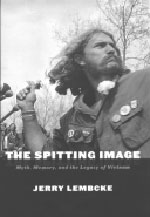 The Spitting Image challenges common beliefs about how soldiers from the Vietnam war were treated
The Spitting Image challenges common beliefs about how soldiers from the Vietnam war were treated
by Benjamin Dangl
Jerry Lembcke is the author of “The Spitting Image: Myth, Memory, and the Legacy of Vietnam”. In 1969, he was assigned to the 41st Artillery Group in Vietnam as a Chaplain’s Assistant, and joined the Vietnam Veterans Against the War when he returned in 1970. As an associate professor of sociology at Holy Cross College during the Persian Gulf War, Lembcke began to research the origins of stories about Vietnam Veterans being spit on by female antiwar protesters. Not only did the stories conflict with Lembcke’s experiences as a veteran and member of the anti-war movement in the 1970’s, he could not find a single documented case of a veteran being spit on.
It was in this research that Lembcke began to realize that the spitting myths also served the Nixon-Agnew administration as political tools with which to damage the image of the antiwar movement, and to bolster the injured masculinity of a country which had just lost its first war.
He also began to question the diagnosis of “post traumatic stress disorder,” which he now argues was an effective way for the administration to discredit the political opinions of veterans. His book was published by New York University Press in July of 1998. In this interview, Lembcke discusses the experiences that led him to write the book, his interpretation of the “spitting myths” as political tools, and applies those ideas to the war in Iraq and the current antiwar movement…
BD: Did your experiences in Vietnam politicize your life, and how?
JL: Most Definitely! I was not political at all before the war. I was drafted in 1968, I had been to college by that that time, had a BA in math, and after graduation in 1966 I took a job as a highschool math teacher in Iowa. Up to that point I had played baseball, basketball, had not been involved politically at all. The draft experience, for me, was kind of a wake-up call. I went to basic training in Washington, and at the end of basic training, I volunteered to go to chaplain’s assistant school. So off I went to Fort Hamilton in New York.
Fall and summer of 1968 was a very raucous time to be in New York City. That was my first exposure to the anti-war movement: meeting and being met by antiwar activists just off the coast of Fort Henry and in Manhattan. The first antiwar rally I witnessed was at St. Patrick’s Cathedral on 5th Ave., and I was standing a half a block away, watching and looking and realizing that hey, these people know something that I don’t know, and probably something that I am going to need to know.
Later, that experience in New York City in that summer became a part of how I knew that the stories about hostilities between antiwar activists and soldiers and veterans weren’t true. It was in that summer of 1968 when a lot of these stories (as rumor would have it) were taking place. I’ve had people tell me that directly: “I was in Manhattan in the summer of 1968, and I’ll tell you, soldiers were getting spat on left and right.” And I’ve even had some veterans tell me: “Well you weren’t there the summer of 1968, so you don’t know what it was like,” and of course I was there, and there was mostly mutual respect and supportiveness between the antiwar movement and the soldiers. I remember that we were offered sanctuary at churches in Brooklyn when we came off the posts at Fort Henry.
So, of course then I went to Vietnam, was sent to Vietnam on New Years day 1969, and stayed all of 1969 and the first few months of 1970 as a chaplain’s assistant, mostly in the central highlands of South Vietnam
ATTENTION READERS
We See The World From All Sides and Want YOU To Be Fully InformedIn fact, intentional disinformation is a disgraceful scourge in media today. So to assuage any possible errant incorrect information posted herein, we strongly encourage you to seek corroboration from other non-VT sources before forming an educated opinion.
About VT - Policies & Disclosures - Comment Policy



